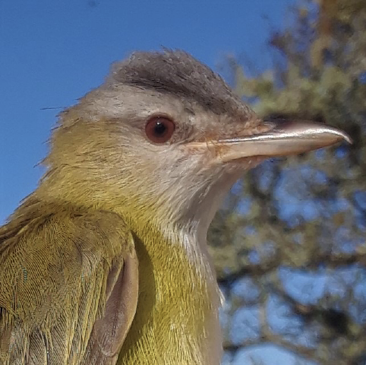
October 15, 2019. Monomoy NWR–Lighthouse. Photo by Valerie Bourdeau.
3 records
| MARC number | Decision | Species | # | Location | County | Arrival | Departure | Observers | Report |
|---|---|---|---|---|---|---|---|---|---|
| 2011-039 | A | Yellow-green Vireo | 1 | Parker River NWR--banding station | Essex | 9/4/2011 | 9/4/2011 | B. Flemer (ph) | 16 |
| 2019-070 | A | Yellow-green Vireo | 1 | Monomoy NWR, Chatham | Barnstable | 10/15/2019 | 10/15/2019 | James Junda* (ph), Sean Williams*† | 24 |
| 2020-054 | A | Yellow-green Vireo | 1 | Andrews Point, Rockport | Essex | 10/3/2020 | 10/4/2020 | Brian Harris* (ph), Lauren Grimes* | 25 |
Yellow-green Vireos are widespread breeders in Mexico south through Central America to Panama. They migrate to southern Central America or northern South America during the nonbreeding season. They are regular visitors to the southern United States, with annual records in either California, Arizona, Texas, Louisiana, and Florida. Yellow-green Vireos prefer broadleaf deciduous forests and are highly migratory.
WHERE TO LOOK IN MASSACHUSETTS: Given this is the only record in the northeast, one should probably simply scan migrant traps along the coast during the summer and early fall and pray to get lucky. Finding another record will likely require careful scan of all Red-eyed Vireos.
STATUS IN THE EAST: Nearly annual from east Texas east to Florida; however the only record north of east Texas is the lone Massachusetts bird.
IDENTIFICATION NOTES: Overall very similar to Red-eyed and Black-whiskered Vireos, and confusion with these can be a serious problem with poor views. Yellow-green Vireos always show a large and pale bill, and a gray cap and crown lacking a black eye line. They also will show more yellow in the plumage, particularly in the undertail coverts, than either Red-eyed or Black-whiskered. Black-whiskered Vireos will show black lateral throat stripes in all plumages, and tend to show darker bills. Red-eyed Vireos also have a dark bill, and the contrasty head pattern (particularly the black eye line) is diagnostic.
